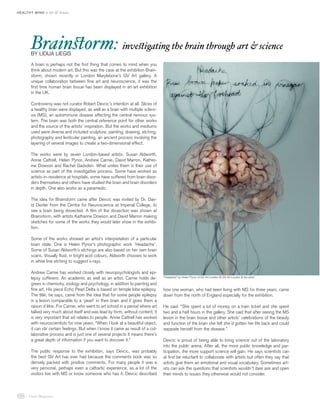More Related Content
Similar to Brainstorm (20)
Brainstorm
- 1. Oasis Magazine88
HEALTHY MIND » Art & Science
A brain is perhaps not the first thing that comes to mind when you
think about modern art. But this was the case at the exhibition Brain-
storm, shown recently in London Marylebone’s GV Art gallery. A
unique collaboration between fine art and neuroscience, it was the
first time human brain tissue has been displayed in an art exhibition
in the UK.
Controversy was not curator Robert Devcic’s intention at all. Slices of
a healthy brain were displayed, as well as a brain with multiple sclero-
sis (MS), an autoimmune disease affecting the central nervous sys-
tem. The brain was both the central reference point for other works
and the source of the artists’ inspiration. But the works and mediums
used were diverse and included sculpture, painting, drawing, etching,
photography and lenticular painting, an ancient process involving the
layering of several images to create a two-dimensional effect.
The works were by seven London-based artists: Susan Aldworth,
Annie Cattrell, Helen Pynor, Andrew Carnie, David Marron, Kather-
ine Dowson and Rachel Gadsden. What unites them is their use of
science as part of the investigative process. Some have worked as
artists-in-residence at hospitals, some have suffered from brain disor-
ders themselves and others have studied the brain and brain disorders
in depth. One also works as a paramedic.
The idea for Brainstorm came after Devcic was invited by Dr. Dav-
id Dexter from the Centre for Neuroscience at Imperial College, to
see a brain being dissected. A film of the dissection was shown at
Brainstorm, with artists Katharine Dowson and David Marron making
sketches for some of the works they would later show in the exhibi-
tion.
Some of the works showed an artist’s interpretation of a particular
brain state. One is Helen Pynor’s photographic work ‘Headache’.
Some of Susan Aldworth’s etchings are also based on her own brain
scans. Visually fluid, in bright acid colours, Aldworth chooses to work
in white line etching to suggest x-rays.
Andrew Carnie has worked closely with neuropsychologists and epi-
lepsy sufferers. An academic as well as an artist, Carnie holds de-
grees in chemistry, zoology and psychology, in addition to painting and
fine art. His piece Echo Pearl Delta is based on temple lobe epilepsy.
The title, he says, came from the idea that for some people epilepsy
is a lesion comparable to a ‘pearl’ in their brain and it gives them a
raison d’être. For Carnie, who went to art school in a period where art
talked very much about itself and was lead by form, without content, it
is very important that art relates to people. Annie Cattrell has worked
with neuroscientists for nine years. “When I look at a beautiful object,
it can stir certain feelings. But when I know it came as result of a col-
laborative process and is just one of several projects it means there’s
a great depth of information if you want to discover it.”
The public response to the exhibition, says Devcic, was probably
the best GV Art has ever had because the comments book was so
densely packed with positive comments. For many people it was a
very personal, perhaps even a cathartic experience, as a lot of the
visitors live with MS or know someone who has it. Devcic described
how one woman, who had been living with MS for three years, came
down from the north of England especially for the exhibition.
He said: “She spent a lot of money on a train ticket and she spent
two and a half hours in the gallery. She said that after seeing the MS
lesion in the brain tissue and other artists’ celebrations of the beauty
and function of the brain she felt she’d gotten her life back and could
separate herself from the disease.”
Devcic is proud of being able to bring science out of the laboratory
into the public arena. After all, the more public knowledge and par-
ticipation, the more support science will gain. He says scientists can
at first be reluctant to collaborate with artists but often they say that
artists give them an emotional and visual vocabulary. Sometimes art-
ists can ask the questions that scientists wouldn’t dare ask and open
their minds to issues they otherwise would not consider.
Brainstorm: investigating the brain through art & science
By lidija liegis
“Headache” by Helen Pynor of GV Art London © GV Art London & the artist.
Oasis 15.indd 88 3/3/11 9:30:45 PM
